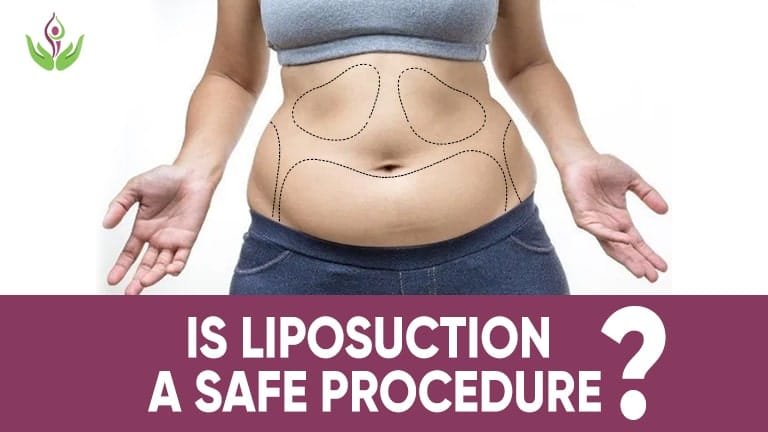Liposuction is a prominent, safe, and safe form of body contouring cosmetic surgery if done by the right doctor under the right medical conditions and equipment. It uproots undesirable stores of abundant fat from the stomach area to enhance body appearance and smooth sporadic or contorted body shapes. The strategy is now and again called body shaping.
In the quest for a slim and trim figure, many seek quick solutions to eliminate excess fat. Despite strict diets and regular workouts, people still yearn for instant results. However, easy solutions often come with a catch.
A few years back, cosmetic surgeries like liposuction were Bollywood’s top secret to perfection. However, nowadays celebrities are open about the changes they have made to achieve the flaunting flawless flat bodies. Moreover, Fat removal surgery was the second most cosmetic procedure in demand after breast augmentation.
So, let us dive deep into this topic named liposuction to understand its mode of action for achieving more aesthetic body contours. It is also the right time to take a close look at its safety factor too. Still, remember that liposuction is not an alternative to weight loss treatment.
Introduction
When it comes to achieving an ideal physique, people often turn towards solutions like liposuction – a widely popular cosmetic treatment offering swift removal of unwanted body fat in problematic areas. Nonetheless, one should exercise caution and take into account all relevant risks involved before opting for this option. To help readers make informed decisions regarding this surgical intervention. Our article examines the matter in depth by discussing the potentially hazardous aspects and analyzing variables one must assess beforehand.
Brief Explanation of Liposuction
Liposuction might be considered for those who want excess fat removed from targeted areas of their bodies, like their legs or abdomen. Undergoing this procedure begins with administering anesthesia for added comfort during surgery. Next up involves making an incision in that part of your body, which then allows for the insertion of a cannula- a thin tube that enables the removal of excess fat via suction with help from vacuum-like devices. Naturally,a range of techniques might be applied, such as traditional liposuction, among others such as ultrasound-assisted methods, while choice depends on factors such as expert preference and individual needs.
Overview of Safety Concerns
- General Risks:
- Infection: Seldomly, there may be a risk of developing an infection at the incision point. But qualified surgeons are diligent in their approach to reducing this possibility through rigorous sterilization measures and attentive aftercare services.
- Bleeding: Some bleeding may occur during or after the procedure, but excessive bleeding is uncommon.
- Bruising and Swelling: These are common side effects that usually subside within a few weeks.
- Anesthesia-related Risks:
- Allergic reactions: It is important to mention that adverse reactions to the anesthesia used during the procedure are extremely uncommon. But some individuals may still experience such a reaction.
- Anesthesia complications: As professionals in the healthcare industry are aware, administering anesthesia during surgery entails some degree of risk for possible complications.
- Surgical Risks:
- Uneven contours: In some cases, the outcome of liposuction may result in uneven contours, which may require additional procedures for correction.
- Numbness: Temporary numbness or changes in skin sensation may occur, but they usually resolve over time.
- Skin irregularities: In rare cases, the skin may appear bumpy or wavy after liposuction. This can be minimized through proper surgical technique.
Short Summary:
Stubborn fat deposits are difficult to eliminate despite exercise and healthy eating. Some turn to liposuction, a surgical solution promising quick results with minimal downtime. However, it carries risks such as infections, excessive bleeding, and blood clots. Seeking guidance from skilled professionals and following safety measures are crucial for safe and effective outcomes.
Understanding Liposuction
Explanation of Liposuction Procedure
Liposuction is a surgery that helps eliminate unwanted fat deposits from particular areas of the body, leading to better body shapes. Initially, the patient is given anesthesia to guarantee patient ease. Subsequently, the doctor carves tiny cuts in a specified location.
In order for Fat reduction surgery to be carried out, an experienced physician must first insert a thin tube called a cannula into tiny incisions throughout particular areas of your body. After inserting, this device becomes connected to an appliance comparable to that of a vacuum – which extracts any excess fat present within our bodies through those narrow tubes securely placed inside our bodies. Fillipo Lorenzetti explains, “The main advantage of the results that come from surgeries such as liposuction is that they not only exclude excess weight removal but also bring additional benefits such as improved health conditions.”
A board-certified doctor handles this surgical tool with precision by constantly maneuvering back-and-forth motions when ejecting these unwanted fatty tissues away from your system. Most surgeries usually conclude within one or multiple hours by considering patients’ desires holistically.
Different Types of Liposuction Techniques
- Traditional Liposuction:
As a plastic surgery process. It’s no secret that suction-assisted liposuction (SAL), also known as traditional lipo, has been around for quite some time now. Conventionally, this is performed by using a cannula linked to an aspirator gadget that manually siphons out fat cells within seconds. This technique proves effective in extracting considerable amounts of fat from desired parts of one’s physique.
- Tumescent Liposuction:
A newer form of Liposculpture known as tumescent surgery uses a specialized injection prior to removing excess fat via suction. Rather than general anesthesia, which can pose risks on its own merits, or older methods that utilized larger incision points that required longer recovery times, this approach relies on injecting smaller amounts of dilute lidocaine mixed with epinephrine into areas where unwanted fat resides – thus minimizing discomfort during fat removal while also reducing bleeding or bruising after the fact.
- Laser-Assisted Liposuction:
SmartLipo and SlimLipo therapies exploit advanced laser energy technology that converts fat cells into the liquid form prior to aspiration from target sites adjacent to your problem area(s). These modalities offer another valuable feature – a stimulating effect on collagen generation, – responsible for toning up your tissues as your skin heals. Besides being most suitable for rejuvenating relatively small sections, such revolutionary laser-assisted liposuctions may also be beneficial if you hope for added skincare benefits postoperatively.
- Ultrasound-Assisted Liposuction:
Individuals seeking effective ways of combating accumulated body fat can explore options such as ultrasound-assisted liposuction (UAL). With this approach, surgeons use high-frequency sound waves emitted from a specialized medical device to convert targeted fatty tissue into liquid form before removal via suction intervention. Typically employed for areas with higher densities of adipose deposits like those covering the upper abdomen region or those found on locations such as a man’s chest or back where persistent deposits may reside despite conventional weight loss efforts.

Short Summary:
Typically used for sculpting body curves to enhance physical appearance, Liposculpture incorporates a surgical procedure formulated specifically for removing excess fatty tissues from certain areas within your anatomy that resist all other weight-loss measures. Advanced technology has ushered in several innovative approaches which give patients more options than before; Traditional liposuction or less invasive procedures such as tumescent liposuction can be complemented with emerging technologies like deliberation andted or ultrasound-guided methods allowing greater precision and benefits suitable for different cases depending on factors such as skin elasticity, volume loss, and other variables – skillful application resulting in excellent results coupled with deliberation practicing caution can only come with experience; Ensure you consult well-qualified plastic surgeons when selecting your preferred procedure.
How Safe is Liposuction?
Cosmetic surgery is safer than before. Anyway, like any other procedure, there are a few risks involved. The risk level depends on the type of procedure as well as medical history. Hence, it is mandatory to discuss all possible risks with your cosmetic surgeon. You also make sure to discuss the likelihood of these risks. However, you will be surprised to hear that it is very low. Still, you should be well informed about the complications if any.
Regarding the safety of liposuction, the risks are very less since the procedure is not specifically invasive. A research study published in the Aesthetic Surgery Journal revealed that the complication rate is only less than 1%by examining around 30000 liposuction cases [1]. In fact, by going through the past international cases of complications of the Adipose tissue extraction procedure, researchers determined that the majority would have been easily avoided by implementing a proper safety protocol.
Another research study published in the Journal of the American Society of Plastic Surgeons revealed that a certified and well-trained plastic surgeon will rarely cause a complication during the Lipo-sculpting procedure [2]. So, it is mandatory to undergo this procedure by a certified, highly skilled, and experienced cosmetic surgeon.
However, the list of side effects is mentioned below which you should be well aware of.
Side effects that subside with time
- Swelling
- Soreness
- Bruising
- Drowsiness due to the use of sedatives
Moderate side effects that require revision (These symptoms do not occur often)
- Burns
- Infection
- Irregular contour
- Fluid accumulation
- Loose skin or rippling
Serious side effects that require surgery (These complications are extremely rare under a qualified cosmetic surgeon’s care)
- Fat embolism (fat enters the blood vessel)
- Deep vein thrombosis or blood clot
- Internal organ damage during cannula puncture
- Kidney problem
- Heart problem
- Lidocaine toxicity
Feel free to enquire about the background of your cosmetic surgeon about their success history to ensure that you are receiving the best-personalized care.
The Importance of Safety in Liposuction
- Anesthesia Risks:
Liposuction surgery requires medication through anesthesia so patients won’t feel uncomfortable during treatment; however, this aspect brings concerns about safety since all surgeries carry inherent risks that must be considered beforehand: such as undesirable drug reactions or even allergic responses that can harm individuals if not treated appropriately. Therefore, receiving high-quality care under a skilled anesthesiologist’s guidance helps mitigate these dangers when performing procedures such as Lipo-sculpting effectively.
- Infection Risks:
Although liposuction may seem like a minor operation, It carries risks like any other medical procedure – especially infections resulting from surgical wounds. When performing such surgeries, doctors must make deep cuts in the skin that can serve as entry points for dangerous bacteria that could cause significant harm if left unchecked. An essential step in preventing these complications lies in adopting hygienic practices and complying with instructions issued by your healthcare provider regarding post-procedure recovery measures.
- Bleeding Risks:
Liposuction is a cosmetic surgical operation aimed at removing excess fatty tissue by suctioning, which might entail some bleeding associated with the procedure’s nature. While mild bleeding after surgery remains close to normal limits, an excessive amount can cause grave complications, posing health hazards for patients in the post-recovery phase. To ensure optimum health benefits for patients undergoing this at-times intricate maneuver, surgical experts utilize varied techniques like controlling blood loss with tumescent fluids and performing controlled suctions during lipo procedures.
- Skin Irregularities:
Liposuction aims to sculpt and contour the body, but there is a risk of developing skin irregularities, such as lumpiness or uneven contours. This risk can be minimized by choosing a surgeon with extensive experience and skill in Fat removal surgery techniques.
- Numbness or Changes in Sensation:
Liposuction can disrupt nerves, leading to temporary or permanent numbness or changes in sensation in the treated areas. This risk varies depending on the extent of the procedure and individual factors. It’s important to discuss this potential side effect with the surgeon during the consultation phase.
Emphasizing the need for a qualified and experienced surgeon
To ensure a safe liposuction experience, it is vital to select a qualified and experienced surgeon. Look for a board-certified plastic surgeon who specializes in liposuction and has a track record of successful procedures. Research the surgeon’s credentials, reviews, and before-and-after photos to make an informed decision.
Highlighting the significance of pre-operative assessments and patient suitability
Pre-operative assessments and patient suitability evaluations are equally important. Surgeons should conduct a thorough medical history review, assess the patient’s overall health, and evaluate their expectations to determine if they are suitable candidates for liposuction. This helps identify any underlying health conditions that may increase the risks associated with the procedure.
Short Summary:
Prioritizing safety in liposuction is of utmost importance. This article discusses the potential risks associated with the procedure, the need for a qualified surgeon, and the significance of pre-operative assessments. By understanding the risks and taking the necessary precautions, individuals can achieve their desired results while minimizing the chance of complications.
Factors that Influence the Safety of Liposuction: A Comprehensive Guide

Liposuction is a popular cosmetic procedure that helps individuals achieve their desired body contours by removing excess fat deposits. While it offers numerous benefits, safety should always remain a top priority. In this article, we will explore the key factors that influence the safety of liposuction, ensuring patients are well-informed before undergoing the procedure.
Patient Selection Criteria:
The first crucial factor in ensuring a safe liposuction procedure is proper patient selection. By carefully evaluating certain aspects, both the surgeon and the patient can determine whether Liposculpture is a suitable option.
- Evaluating General Health and Medical History:
Before undergoing Fat removal surgery, patients must disclose their complete medical history to the surgeon. This information helps identify any pre-existing conditions or factors that may increase the risks associated with the procedure.
- Assessing BMI and Realistic Expectations:
Body Mass Index (BMI) plays a significant role in determining a patient’s candidacy for liposuction. A thorough examination of the patient’s BMI helps assess their overall health and the amount of fat that can be safely removed. Additionally, setting realistic expectations is essential for patient satisfaction.
- Identifying Specific Medical Conditions or Contraindications:
Certain medical conditions, such as heart disease, diabetes, or compromised immune systems, may pose a higher risk during liposuction. Identifying these conditions beforehand allows the surgeon to make informed decisions and take appropriate precautions.
Surgeon’s Expertise and Qualifications:
One of the key determinants of the safety of liposuction is the qualifications and credentials of the surgeon performing the procedure. It is crucial to choose a board-certified plastic surgeon who has undergone rigorous training and possesses extensive experience in performing Liposculpture surgeries. Reviewing the surgeon’s credentials, certifications, and patient testimonials can provide valuable insights into their expertise and patient satisfaction. The skills and qualifications of the surgeon performing liposuction are paramount to a safe procedure and successful outcomes.
- Importance of Choosing a Board-Certified Plastic Surgeon:
Opting for a board-certified plastic surgeon ensures that the individual has undergone rigorous training and possesses the necessary expertise in performing Fat reduction surgery. These professionals adhere to strict safety standards and are well-versed in advanced techniques.
- Researching the Surgeon’s Experience and Track Record:
Patient research is vital when selecting a surgeon for liposuction. Examining the surgeon’s experience, credentials, and track record provides insight into their past performances and patient satisfaction levels. Patient testimonials and reviews can offer additional valuable information.
Quality of the Surgical Facility and Equipment:
The safety of liposuction also depends on the quality of the surgical facility and the equipment used during the procedure.
- Discussing the Importance of Accredited Facilities:
Choosing a surgical facility that is accredited and meets stringent safety standards is crucial. Accreditation ensures that the facility adheres to specific protocols, maintains cleanliness, and employs highly trained staff.
- Ensuring the Use of Advanced Technology and a Sterile Environment:
Utilizing state-of-the-art equipment and maintaining a sterile environment during liposuction helps reduce the risk of complications. Advanced technology can enhance precision and minimize trauma, resulting in safer and more effective outcomes.
Ensuring the safety of liposuction involves various factors that must be considered before undergoing the procedure. Patient selection criteria, the surgeon’s expertise, and the quality of the surgical facility and equipment are essential components in achieving a safe and successful Fat reduction surgery experience. By prioritizing these factors, patients can confidently embark on their journey toward achieving their desired body contours.
Short Summary:
This article examines key factors impacting liposuction safety: patient selection, surgeon expertise, facility quality, and equipment. Evaluating health, BMI, and medical conditions empowers patients to make informed decisions. Choosing experienced, board-certified plastic surgeons enhances safety. Accredited facilities and advanced technology in sterile environments are crucial for successful liposuction.
Preparing for a Safe Liposuction Procedure

Liposuction is a surgical procedure that aims to remove excess fat deposits from specific areas of the body. To ensure a safe and successful Fat reduction procedure, thorough preparation is essential. Here are the step-by-step guidelines to prepare for liposuction surgery:
Pre-operative consultations and discussions
Before the procedure, it is crucial to have in-depth consultations and discussions with the patient. This allows the surgeon to address any concerns and expectations the patient may have, ensuring a clear understanding of the desired outcome.
- Addressing patient concerns and expectations:
- Take the time to listen to the patient’s concerns and understand their desired results.
- Answer any questions they may have regarding the procedure, potential risks, and recovery.
- Detailed explanation of the procedure and recovery process:
- Provide a comprehensive overview of the liposuction procedure, including the techniques used and the expected recovery timeline.
- Discuss any potential risks, complications, and post-operative care instructions.
Medical evaluations and tests:
To ensure the patient’s safety during the liposuction procedure, thorough medical evaluations and tests are necessary.
- Blood tests and general health assessments:
- Conduct comprehensive blood tests to assess the patient’s overall health.
- Evaluate factors such as blood clotting ability, liver function, and general fitness.
- Assessing cardiovascular and respiratory health:
- Perform cardiovascular and respiratory assessments, including EKGs and pulmonary function tests.
- Identify any underlying conditions that may increase the risk of complications during surgery.
Preparing the body for surgery:
Preparing the body for liposuction surgery involves making necessary adjustments to medications and lifestyle habits, as well as ensuring proper hydration and nutrition.
- Medication adjustments and lifestyle modifications:
- Review the patient’s current medications and adjust them if necessary, particularly those that can increase bleeding risk.
- Advise the patient to abstain from smoking and alcohol consumption for a specific period before surgery to promote optimal healing.
- Guidance on proper hydration and nutrition:
- Encourage the patient to maintain proper hydration by drinking an adequate amount of water leading up to the surgery.
- Provide dietary guidance, emphasizing a balanced diet with sufficient nutrients to support the body’s healing process.
Short Summary:
In summary, thorough preparation for a liposuction procedure involves pre-operative consultations to address patient concerns and set realistic expectations. Medical evaluations and tests assess the patient’s overall health, while guidance on medication adjustments, lifestyle modifications, hydration, and nutrition help prepare the body for surgery. By following these steps, patients can enhance the safety and effectiveness of their liposuction procedure.
Safety Measures during Liposuction Surgery
Liposuction surgery is a popular cosmetic procedure aimed at removing excess fat deposits and contouring the body. While liposuction can yield excellent results, it is crucial to prioritize patient safety during the entire process. In this article, we will discuss the key safety measures that should be taken during liposuction surgery.
Anesthesia administration and monitoring:
- Different anesthesia options and their safety considerations:
When performing liposuction surgery, the anesthesia options may vary depending on the patient’s needs and the extent of the procedure. The choices may include local anesthesia, regional anesthesia, or general anesthesia. The selection is made after considering factors such as patient comfort, pain management, and the surgeon’s expertise. Each option carries specific safety considerations that need to be addressed to minimize potential risks.
- Continuous monitoring of vital signs during the procedure:
Regardless of the type of anesthesia used, continuous monitoring of vital signs is crucial to ensuring patient safety. This includes monitoring heart rate, blood pressure, oxygen saturation, and respiration rate. An experienced anesthesiologist or anesthetist closely observes these parameters throughout the surgery to promptly address any abnormalities that may arise.
Sterile technique and infection prevention:
- Proper disinfection and aseptic practices:
Maintaining a sterile environment during liposuction surgery is essential to prevent the introduction of bacteria and minimize the risk of infection. The surgical team follows strict disinfection protocols, including thorough hand hygiene, wearing sterile gloves, and using sterilized instruments and equipment.
- Reducing the risk of post-operative infections:
In addition to maintaining sterile technique, post-operative care plays a vital role in preventing infections. Patients are provided with detailed instructions on wound care, antibiotics if necessary, and regular follow-up visits to monitor healing and address any potential signs of infection.
Techniques for minimizing bleeding and bruising:
- Use of vasoconstrictors and epinephrine:
Vasoconstrictors and epinephrine are commonly employed during liposuction surgery to constrict blood vessels and minimize bleeding. These medications are typically injected into the targeted areas before the procedure, reducing the risk of excessive bleeding and subsequent complications.
- Gentle and precise surgical techniques:
Surgeons use gentle and precise techniques during liposuction surgery to minimize tissue trauma, bruising, and swelling. This includes using small, strategically placed incisions, employing microcannulas for fat removal, and utilizing advanced surgical instruments that allow for more precise movements.
Short Summary:
In conclusion, prioritizing safety measures during liposuction surgery is of utmost importance to ensure optimal outcomes and patient satisfaction. By carefully administering anesthesia, maintaining sterile technique, and employing techniques to minimize bleeding and bruising, the surgical team can significantly reduce the potential risks and complications associated with the procedure.
Post-Operative Care and Safety Considerations
When it comes to undergoing a surgical procedure, proper post-operative care is crucial for a successful recovery. This article will outline important steps to follow in order to ensure a safe and smooth healing process. From monitoring and follow-up appointments to pain management and recovery tips, we will cover all the essential aspects of post-operative care.
Monitoring and Follow-Up Appointments
- Importance of Post-Operative Check-Ups: After any surgical procedure, it is vital to attend scheduled follow-up appointments with your healthcare provider. These appointments allow the medical team to monitor your progress, assess any potential complications, and make any necessary adjustments to your treatment plan.
- Addressing Any Concerns or Complications: During these check-ups, it is crucial to openly communicate any concerns or complications you may be experiencing. This could include pain, swelling, redness, or any other unexpected symptoms. Your healthcare provider will be able to evaluate these issues and provide appropriate guidance or interventions.
Pain Management and Medication Guidelines
- Prescribing Appropriate Pain Relief Medications: Depending on the nature of the surgery, your healthcare provider may prescribe pain relief medications to manage post-operative pain. These medications could include non-steroidal anti-inflammatory drugs (NSAIDs), opioids, or other suitable options.
- Instructions for Medication Usage and Potential Side Effects: It is essential to carefully follow the prescribed medication guidelines provided by your healthcare provider. This includes the correct dosage, frequency, and duration of medication use. Additionally, be aware of potential side effects and contact your healthcare provider if you experience any adverse reactions.
Recovery and Healing Process
- Expected Timeline for Recovery and Returning to Normal Activities: The recovery process varies depending on the type of surgery and individual factors. Your healthcare provider will provide an estimated timeline for your recovery, including when you can resume normal activities such as work, exercise, or driving. Follow these guidelines to avoid complications and promote optimal healing.
- Tips for Minimizing Swelling and Promoting Healing: To aid in the recovery process, there are several steps you can take at home. These include proper wound care, avoiding excessive physical strain, applying ice packs to reduce swelling, and following a nutritious diet to support healing.
Short Summary:
In summary, post-operative care is essential for a safe and successful recovery. By attending follow-up appointments, adhering to medication guidelines, and following recovery tips, you can optimize your healing process and minimize any potential complications.
Long-Term Safety and Results of Liposuction: Maintaining a Healthy Lifestyle Post-Surgery
Liposuction is a popular cosmetic surgical procedure that helps individuals achieve their desired body shape by removing excess fat deposits. While the immediate results of liposuction can be gratifying, it is essential to understand the longevity of these outcomes and the significance of maintaining a healthy lifestyle after surgery. This article explores the long-term safety and results of liposuction, emphasizing the importance of post-surgery habits for sustained success.
Discussing the longevity of liposuction results:
Liposuction effectively eliminates localized fat deposits, reshaping specific areas of the body. However, it is important to note that liposuction does not prevent future weight gain or guarantee permanent results. The longevity of liposuction results largely depends on the individual’s commitment to a healthy lifestyle following the procedure.
Importance of maintaining a healthy lifestyle post-surgery:
- Diet and exercise recommendations:
After liposuction, adopting a nutritious diet and incorporating regular exercise into one’s routine are crucial. A balanced diet consisting of lean proteins, whole grains, fruits, and vegetables aids in weight maintenance and overall well-being. Consulting with a nutritionist can help tailor a diet plan that meets individual needs. Physical activity is equally vital to sustaining the benefits of liposuction. Engaging in regular exercises, such as cardiovascular workouts, strength training, and flexibility exercises, helps burn calories, tone muscles, and maintain a healthy weight.
- Weight management strategies:
To ensure long-lasting results, individuals should monitor their weight post-surgery. Here are some strategies for effective weight management:
- Regular weigh-ins: Monitoring weight fluctuations enables individuals to identify changes and take necessary action promptly.
- Portion control: Practicing mindful eating and controlling portion sizes can help individuals maintain a healthy weight.
- Hydration: Drinking an adequate amount of water promotes proper metabolism, aids in digestion, and helps manage cravings.
- Stress management: Stress can lead to emotional eating and weight gain. Incorporating stress management techniques such as meditation, yoga, or engaging in hobbies can help maintain a healthy mindset.
Short Summary:
Liposuction removes stubborn fat deposits, but long-term results rely on a sustained healthy lifestyle. Through nutritious diet, exercise, and weight management, individuals can enhance and prolong liposuction benefits. It’s not a substitute for healthy living, but a tool alongside long-term commitment to overall well-being.
Common Myths and Misconceptions about Liposuction Safety
Liposuction is a popular cosmetic procedure designed to remove stubborn fat deposits and contour the body. Despite its widespread use, there are several misconceptions surrounding its safety and effectiveness. In this article, we aim to address these myths and provide evidence-based information to dispel any misunderstandings.
Addressing misconceptions about risks and complications:
- Myth: Liposuction is a dangerous and high-risk procedure.
Contrary to this belief, liposuction is generally considered safe when performed by a skilled and experienced plastic surgeon. Like any surgical procedure, liposuction does carry some risks, but severe complications are rare. The advancements in technology and techniques have significantly improved patient safety, making liposuction a viable option for many individuals seeking body contouring.
- Myth: Liposuction results in immediate weight loss.
While liposuction can eliminate unwanted fat cells, it is not a weight-loss procedure. Its primary goal is to remove localized fat deposits that are resistant to diet and exercise. Liposuction helps improve body contours and proportions, leading to a more sculpted appearance. It is crucial to maintain a healthy lifestyle after the procedure to enjoy long-term benefits.
Providing evidence-based information to dispel myths:
- Safety measures and precautions: Accredited plastic surgeons prioritize patient safety by conducting thorough pre-operative assessments, discussing potential risks, and ensuring proper surgical facility standards.
- Individualized approach: Each patient’s anatomy and goals are unique, which is why liposuction procedures are tailored to suit their specific needs. A comprehensive consultation with the surgeon helps determine the most suitable technique and approach for optimal results.
- Recovery and downtime: Liposuction is an outpatient procedure, and the recovery period varies based on the extent of the treatment. Following post-operative instructions, wearing compression garments, and maintaining a healthy lifestyle aid in swift recovery and reduce the risk of complications.
- Realistic expectations: Understanding the limitations of liposuction is crucial. It is not a substitute for a healthy lifestyle or a treatment for obesity. Liposuction is most effective when used as a tool to contour specific areas of the body and enhance overall body proportions.
Short Summary:
Liposuction is often misunderstood due to various myths surrounding its safety and outcomes. This article dispels two common misconceptions, highlighting the safety measures, individualized approach, recovery process, and realistic expectations associated with liposuction. By providing evidence-based information, individuals can make informed decisions about this popular cosmetic procedure.
Alternatives to Liposuction
For individuals who are not suitable candidates for liposuction or prefer non-surgical alternatives, there are several options available. These include non-invasive fat reduction treatments such as cryolipolysis (CoolSculpting), radiofrequency-based devices, and injectable fat-dissolving agents. It is advisable to consult with a qualified cosmetic professional to determine the most appropriate alternative based on individual needs and expectations.
Conclusion
Liposuction is a cosmetic procedure that offers individuals the opportunity to reshape their bodies and enhance their self-confidence. While it is generally safe, it is essential to consider the qualifications of the surgeon, understand the potential risks and complications, and have realistic expectations regarding the outcomes.
By approaching liposuction with caution and making informed decisions, individuals can achieve their desired results while prioritizing their safety and well-being.














